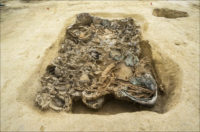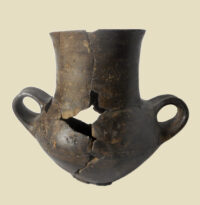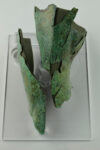 Objects recovered from a high-status grave of the Piceni people discovered in Corinaldo, in the central Italian region of Le Marche, have gone on display for the first time. Unearthed in 2018, the princely chariot grave was unusual for the richness of its funerary furnishings and for its location in the north of Le Marche. Other monumental graves of the period found in Le Marche were in the south of the region.
Objects recovered from a high-status grave of the Piceni people discovered in Corinaldo, in the central Italian region of Le Marche, have gone on display for the first time. Unearthed in 2018, the princely chariot grave was unusual for the richness of its funerary furnishings and for its location in the north of Le Marche. Other monumental graves of the period found in Le Marche were in the south of the region.
The tomb’s presence was first discovered from the air, during an aerial survey performed as part of a preventive archeology campaign at a site scheduled for construction of a new sports complex. The flyover revealed ring ditches in the vegetation that are typical of large graves of high-ranking individuals in Piceni necropoli. They were likely tumuli (the mounds are now gone) and were ringed by moats.
 The excavation unearthed a funerary complex with at least four circular tombs datable to between the 6th and 8th centuries B.C. The large tombs belonged to the elite and were richly furnished with grave goods, as a rule. Inside the central ring was a grave crammed with a mass of objects, including more than 100 ceramic vessels and an iron-wheeled chariot. It dates to the first half of the 7th century B.C.
The excavation unearthed a funerary complex with at least four circular tombs datable to between the 6th and 8th centuries B.C. The large tombs belonged to the elite and were richly furnished with grave goods, as a rule. Inside the central ring was a grave crammed with a mass of objects, including more than 100 ceramic vessels and an iron-wheeled chariot. It dates to the first half of the 7th century B.C.
 A selection of 12 objects from the first batch of finds has now gone on temporary display in Corinaldo’s public art gallery. The artifacts were chosen as representations from two significant aspects of the lifestyle of the Piceni rich and famous: banqueting and war. Items on display include drinking vessels, skewers and andirons used to spit and cook meat, a bronze helmet, bronze greaves and one of two iron wheels from the chariot.
A selection of 12 objects from the first batch of finds has now gone on temporary display in Corinaldo’s public art gallery. The artifacts were chosen as representations from two significant aspects of the lifestyle of the Piceni rich and famous: banqueting and war. Items on display include drinking vessels, skewers and andirons used to spit and cook meat, a bronze helmet, bronze greaves and one of two iron wheels from the chariot.
These are twelve pieces that best express the most representative ideological components of the trousseau and its multiplicity of meanings: a helmet and a greaves celebrate the dimension of political and military power, the chariot symbolizes land ownership, the funeral banquet ceremony is represented. from containers to accommodate and pour food and drinks, and the meat sacrifice with the practices of cutting and cooking dedicated animal meats is evoked by the ax, skewers and andirons.
The exhibition therefore aims to tell the public about this important archaeological discovery , making known even to non-specialists all the methodologies adopted and the long and laborious work that hides behind an excavation, paying homage to the local community which has always shown a profound interest and cultural involvement, in the hope that the project will merge into a permanent museum.